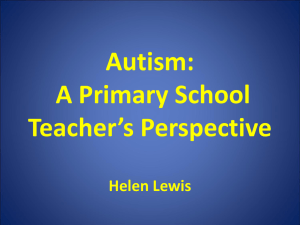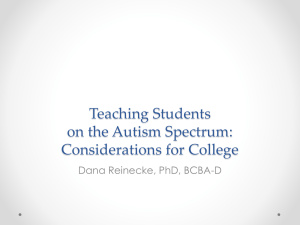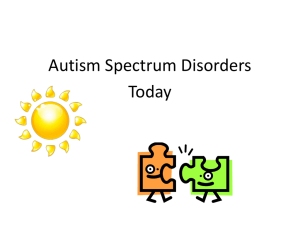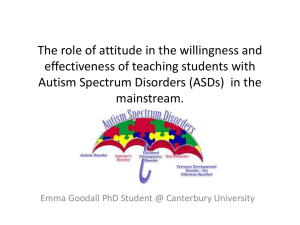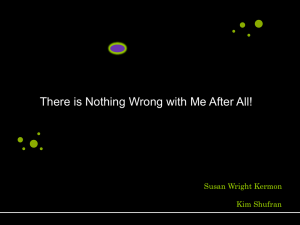Autism in Infants and Young Children PowerPoint
advertisement
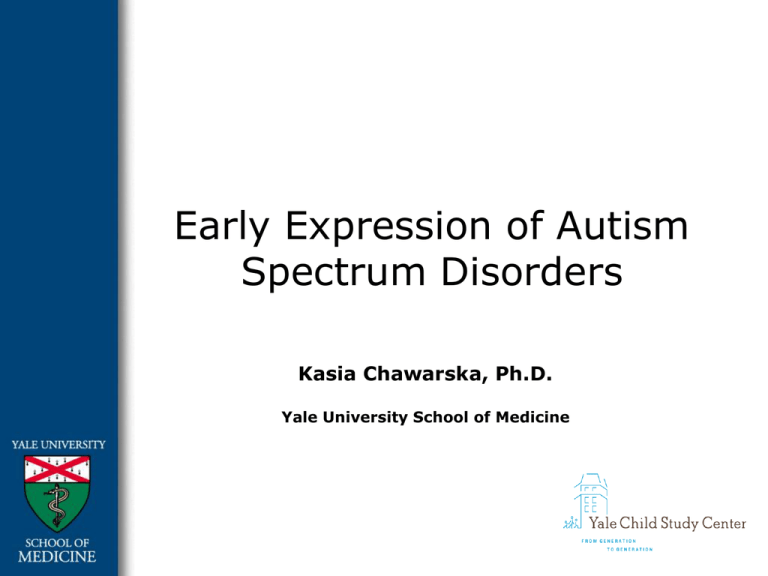
Early Expression of Autism Spectrum Disorders Kasia Chawarska, Ph.D. Yale University School of Medicine Overview • Onset and diagnosis • Syndrome expression • Face processing Autism: Clinical Features • Classic triad of symptoms: – Impaired social interaction – Impaired communication – Presence of restricted interests and activities • Onset prior to 36 months • Diagnosis often delayed • Marked heterogeneity • Developmental disorder Leo Kanner Age of Onset: Parental Perception • Average age at first concern: 25 20 – 15 months (SD=6.5) • Primary concerns: Percent 15 10 – Social difficulties – Speech delays 5 0 0-2 • Why such a variability? 3-4 5-6 7-8 9-10 11-12 13-14 15-16 17-18 19-20 21-22 Age (monhts) Chawarska, Paul, Klin et al., 2007, JADD. 23-24 Patterns of Onset • Early onset (1st year): – “Inborn autistic disturbances of affective contact” (Kanner, 1943) • Later onset (2nd year): – Regression (15-27% of cases) (Eisenberg & Kanner, 1955; Dawson et al., 2006; Landa et al., 2007) – Plateau (Ozonoff et al., 2008; Hansen et al., 2008) Methodological Approaches to Studying Emergence of Autism • Retrospective studies of affected children – Parental report – Video diaries analysis • Prospective studies of infant siblings at risk for ASD – Recurrence risk for autism: 5-10% – High risk for other developmental problems: • Language or cognitive delays • Broader Autism Phenotype, BAP Autism in the First Year Potential Areas of Dysfunction in the 1st Year 1. Typical Development – 0 to 3 months: • – 3 to 6 months: • – – Sensitivity to and preference for face-like stimuli and speech-like sound Emergence of dyadic social interactions 6 to 9 months: • Development of face processing skills (identity, affect, gender) • Response to name • Anticipatory social games 9 to 12 months: • Social monitoring and imitation • Social referencing • Joint attention 2. Many skills affected in toddlers with ASD emerge typically in the first year Autism at 6 months? • Reports of typical presentation at 6 months in children with autism – Eye contact and affective responses to mother (Young et al., 2009) – Social reciprocity and attention (Bryson et al., 2006; Zwaigenbaum et al., 2005) – Verbal and nonverbal skills (Landa et al., 2007) • Emerging consensus that overt symptoms of ASD begin to emerge between 6 and 12 months • Possible factors responsible for these findings: – Natural course of autism – Limited sensitivity of existing behavioral methods Emerging Symptoms of Autism at 12 months • Limited response to name – High specificity for ASD (89%) – Low sensitivity (50%) • Limited eye contact and use of communicative gestures: pointing, showing • Delays in language: limited range and frequency of vocalizations • Atypical behaviors: Spinning and intense visual examination of objects ASD in Toddlers Abnormalities in Social Interaction • Limited interest in people • Limited of social reciprocity: – Social smile – Shared enjoyment – Pleasure derived from interactions • Unusual eye contact • Limited affective range • Limited joint attention skills • Poor observational/imitative learning Chawarska, Klin & Volkmar (2008). Autism in Infants and Toddlers. Communication • Low frequency of communication • Paucity of conventional and descriptive gestures (nonverbal communication) • Limited goals of communication (instrumental versus declarative) • Stereotypical/idiosyncratic use of language (e.g., echolalia, scripting) • Use of other’s body to communicate (hand-over-hand gestures) Abnormalities in Play and Imagination Development Exploratory: present but often atypical Functional: may be spared but atypical Pretend: Absent Present but atypical, nongenerative Restricted Interests and Repetitive Behaviors • Seeking/avoiding specific visual stimuli (lights, motion, touch) • Seeking sensory input (jumping, rocking, spinning) • Interest in details of objects (e.g., wheels, dials) • Hand and finger mannerisms Exceptional Abilities • John Longdon Down: Idiot Savant (1887) • Savant skills in autism – More frequent in males – Prevalence 1-10% in autism, less prevalent in other disorders • Etiology: unknown • Examples of savant skills: – Exceptional memory – Computational skills – Artistic abilities – Musical skills Stephen Wiltshire Unusual Abilities in Toddlers • Exceptional skills – Interest in shapes, letters, numbers – Early recognition of signs (“reading”) – Good expressive vocabulary – Great memory for movies, books • Limited functionality such skills – Isolated – Repetitive & restrictive (e.g., labeling, scripting) – Potentially transient Diagnostic Assessment Diagnostic Assessment Battery for Toddlers • Developmental tests: e.g., Mullen Scales of Early Development • Autism-specific delays and abnormalities: Autism Diagnostic Observation Schedule –Toddler Version • Communication: Communication and Symbolic Behaviors Scale • Adaptive skills: Vineland Adaptive Behaviors Schedules-II • Medical and developmental history interview • Genetic and neurological testing Stability of Early Clinical Diagnosis • Short term stability (2nd year to 4 years) (Chawarska et al., 2007; 2009) – Very good for ASD diagnosis (80-90%) – Changes expected within spectrum due to shifts in number of symptoms and intensity • Long term stability (2 to 4 to 9 years) (Lord et al., 2006) – High stability of ASD diagnosis (90%) – Shift from PDD-NOS to Autism Dx: ~20% – Shift from Autism to PDD-NOS: ~10% Stability of Clinical Diagnosis Confirmatory Diagnosis at >3 yrs N (%) Provisional Diagnosis < 2 yrs Autism PDD-NOS Non-ASD Autism 32 (74%) 11(26%) 0 (0%) 43 PDD-NOS 3 (16%) 15 (83%) 0 (0%) 18 Non-ASD 1 (4%) 2 (7%) 25 (89%) 28 36 28 25 89 Total Total Chawarska, Klin, Paul, Macari, & Volkmar, 2009, JCPP Case Study Female high-risk infant followed from 6 to 36 months Case Study: Verbal and Nonverbal Scores Nonverbal Skills Verbal skills 48 Mental Age (months) 42 36 30 24 18 12 6 0 6m 12m 18m 24m Chronological Age (months) 36m Case Study: ADOS Total Score Social Affect Repetitive Behaviors 18 16 ADOS score 14 12 10 8 6 4 2 0 15m 18m 24m Chronological Age 36m Vineland Adaptive Skills: Communication Expressive Recetpive Written 60 Mental Age (months) 54 48 42 36 30 24 18 12 6 0 12m 18m 24m 36m Video not available Eye-Tracking Studies of Face Processing • Scanning as active process of seeking task-relevant information • Visual scanning is affected by: – Perceptual factors (e.g., high contrast, motion, etc.) – Semantic factors (e.g., familiarity with a specific face, nature of the task) – Individual characteristics (e.g., age, disorders) From: A.R. Yarbus, 1965 Face Scanning in Babies Face Scanning and Recognition Visual Paired Comparison Paradigm Familiarization Test of recognition Effect of Context on Face Scanning in Infancy Eyes Mouth 1 0.9 STATIC SMILING SPEAKING 0.8 % Time 0.7 0.6 0.5 0.4 0.3 0.2 0.1 0 3m 6m 9m 12m 3m 6m 9m 12m Chronological Age 3m 6m 9m 12m Atypical Face Processing in Toddlers with ASD Face Processing in Autism • Deficits in face processing in older children and adults – Face recognition – Atypical face processing strategies (features over configurations) – Atypical brain activation pattern in response to faces • Developmental end-points versus developmental process How toddlers with ASD scan and recognize faces? Face Scanning and Recognition: Toddlers Age 1: 26 months (SD=6.5) Age 2: 47 months (SD=5.5) Fixed-trial Visual Paired Comparison paradigm Sequence of six trials using unfamiliar faces Measure of recognition: Novel/Novel+Familiar time ASD N=32, TD N=46 Phase Duration centering 1s Familiarization (10 s)* blank 5s centering 1s Recognition 5s Display Chawarska & Shic, 2009 Regions of Interest Example of the face stimulus and Regions of Interest (ROI) demarcation Eyes Mouth Nose Inner Outer (cheeks/forehead, neck/body, hair) Non-Face (screen, background). Face Scanning and Recognition 0.7 ASD_2 yrs ASD_4yrs 0.6 0.5 • Recognition: TD: Novel > Familiar, p < .01 NP =.56 (.07), p < .001 ASD: Novel = Familiar NP =.51 (.11), p < .23 • Scanning vs. Recognition: More exclusive focus on Eyes associated with less effective encoding, r=-.42, p < .01 TD_2yrs TD_4yrs 0.4 0.3 0.2 0.1 0 Inner Outer Nonface 0.7 ASD_2 yrs ASD_4yrs 0.6 0.5 TD_2yrs TD_4yrs 0.4 0.3 0.2 0.1 0 Eyes Mouth Nose Face versus Object Recognition Nineteen toddlers with ASD (age: M=41 m, SD=14) Novelty Preference: Objects: M = .56 (.10), t(18) = 2.5, p <.02) Novelty Preference: Faces M=.52 (.11), t(16) = .67, p ns. Bradshaw, Shic, Chawarska, submitted Are there autism-specific deficits in the attentional aspects of face processing in toddlers with ASD? Privileged Attentional Status of Faces Faces are detected faster than objects Faces hold attention more strongly than objects • Increased cost of disengagement of attention away from a face: increase in reaction time • Noted in response to neutral and affective faces • Possibly modulated by presence of direct eye contact Attentional Bias for Faces in ASD Overlap attention cueing paradigm ASD (N=42), DD (N=31), TD (N=46) CA-matched groups: 29 months (15 to 60 months) DD and ASD matched on verbal and nonverbal mental age Dependent variables: Saccadic Reaction Time (SRT) (Chawarska, Volkmar, & Klin, in press, Arch.Gen. Psychiatry Procedure NONSOCIAL CONDITION SOCIAL CONDITION Saccadic Reaction Time ASD 400 DD TD 350 * SRT (ms) 300 * 250 200 150 100 50 0 Non-Social Averted Gaze SRT NonSocial: ASD = DD = TD SRT Social (p<.008): ASD < DD = TD DirectGaze = IndirectGaze Direct Gaze Not a Captive Audience… • Faces do not elicit attentional bias in toddlers with ASD • This effect is specific to ASD • Are toddlers with ASD simply faster at processing faces? Faster to Disengage: What Does it Mean? • Speed of processing? – Poor recognition despite attending to faces (Chawarska & Shic, 2009, Chawarska & Volkmar, 2007) • Depth of processing? – Perceptual features (e.g., face-no face, male-female) – Semantic features (e.g., mom-not mom, nice-mean) • Faces in ASD are processed on a more superficial level as indexed by diminished disengagement cost and poor recognition skills Face Processing Abnormalities in Toddles with ASD • Limited attentional bias for faces • Deficit in face recognition • Restricted scanning of key features linked to less effective encoding • Face scanning pattern might become more abnormal with age • Next frontier: – Primary or secondary impairments? – Are other aspects of face processing affected as well? Early Expression of ASD • Symptoms of social dysfunction are apparent in a majority of cases by 24 months • Early Autism Spectrum diagnosis is relatively stable • High variability in the rate of progress reflected in changes of diagnostic classification within spectrum, IQ, and verbal ability • Next frontier: – ASD in the 1st year – Parsing heterogeneity of syndrome expression Thank you



